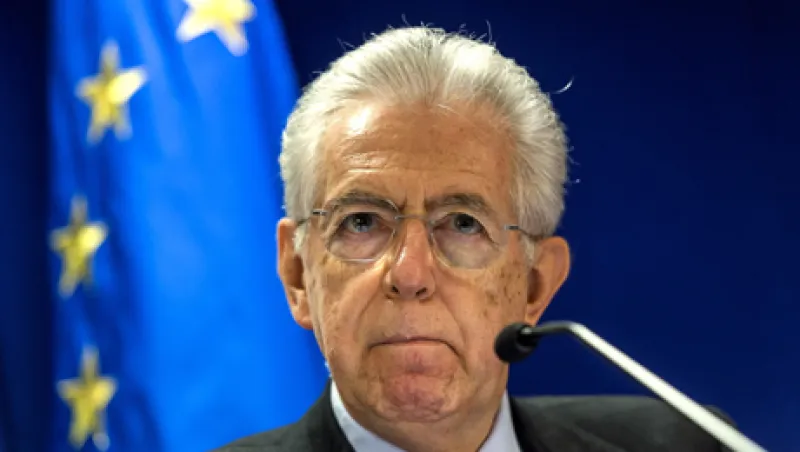Thursday delivered a rude shock to institutional investors hoping that an event-free couple of weeks would usher them into Europe’s protracted Christmas and New Year vacation period, leaving them fresh for another potentially turbulent year on their return.
On the political front, Italy’s technocratic government, which has rescued the country from fiscal oblivion, came a step closer to collapse.
On the interest rate front, Mario Draghi, president of the European Central Bank, signaled that the ECB is ready to take further monetary measures to inject much-needed vigor into the ailing euro zone economy.
The ECB left its benchmark main refinancing rate unchanged at 0.75 percent after Thursday’s monthly monetary policy meeting.
However, at the postmeeting press conference, Draghi was considerably more explicit than in recent months about the possibility of additional interest rate action to aid the euro zone.
“There was a wide discussion” about interest rates, Draghi said about the meeting.
Analysts think the ECB could cut its main refinancing rate — the principal rate at which it lends money to banks — by a further 25 basis points in the next few months, to 0.5 percent. Commenting after the Thursday conference, Deutsche Bank confirmed its forecast of a 25 bp reduction at the end of the first quarter.
Draghi also gave the clearest sign yet that the ECB is seriously entertaining the idea of pushing its benchmark deposit rate into negative territory — following the example of the Danish central bank in July. Analysts have speculated on the possibility of the ECB doing the same ever since its decision, also made in July, to cut the rate from 0.25 percent to zero. Draghi said the ECB was “operationally ready” for a negative deposit rate. He added that the rate-setting Governing Council “briefly touched upon the complexities that such a measure would involve and possible unintended consequences.” In response to Draghi’s comments forward euro money market rates for July and August briefly turned negative.
Making the deposit rate negative would, in effect, punish banks for keeping money at the ECB by charging them for it. In theory, this should increase the incentive for banks to do something else with it, such as generating economic growth by lending it to businesses.
Critics warn, however, of deleterious unintended consequences, including the possibility that it could result in a mispricing of risk across the economy. Banks might be tempted to lend to clients at low rates that do not take full account of the risk of not being paid back, simply in order to avoid negative deposit rates.
However, advocates of a negative deposit rate say it could help solve what many analysts have come to see as the next stage of the euro zone crisis following the stabilization of peripheral nations’ previously unaffordable sovereign bond rates. This next stage is the low output growth with which euro zone member states are saddled, as the fiscal austerity necessary to cut debt reins in gross domestic product.
However, Thursday’s news from Italy throws into question the cozy assumption that even the first stage of the sovereign debt crisis is over.
Yields on the benchmark 10-year Italian government bond leapt 10 bps to 4.56 percent after Silvio Berlusconi’s centre-right People of Liberty party withheld parliamentary support for an economic reform bill championed by the government, before easing to 4.52 percent, up 6 bps on the day. This political ruckus raises the prospect of an imminent election, since the withdrawal of support by Berlusconi’s party leaves Prime Minister Mario Monti’s government without the absolute majority in the senate needed to govern.
The accession of the Monti regime in November 2011 was the key event that prevented Italy’s sovereign debt crisis from spiraling out of control. Monti reassured investors by implementing a slew of reforms to reduce Italy’s deficit and lift the country’s meager underlying growth rate, which is among the lowest in the industrialized world. Any sense among investors that Italy is returning to the political paralysis of the pre-Monti era could send Italian yields spiraling higher.
If Italy’s hard-won consensus for reform unravels, the country next year could prove a bigger risk to institutional investors with euro zone exposure than Greece or Spain.
Many investors regard Greece’s heavy debt burden as unbearable in the long term, despite a series of fixes so far designed to make it so, including debt write-offs and reduced interest rates. However, the Greek government’s willingness to accept austerity — more or less, at least — increases the political acceptability of further fudges by euro zone institutions designed to enable Greece to shoulder its debt load. One among several possibilities open to the ECB and other Greek bondholders is to reduce to zero the interest payable by Greece on loans.
Some analysts worry more, instead, about Spain’s prospects next year, because its much larger size makes it harder for euro zone institutions to make similar radical concessions to keep the Spanish debt market sustainable.
However, institutional investors retain a fairly strong faith in the Spanish government’s ability to respond to future crises. The present centre-right administration, led by Mariano Rajoy, has shown itself willing both to impose fiscal austerity and to make radical changes to the labor market in order to boost growth.
The receding danger from Greece and Spain, combined with the resurgent risk from Italy, suggests that Italy could next year resume its erstwhile status as the greatest obstacle to a resolution of the euro zone crisis.
The key consideration for many analysts is whether a country’s politicians are willing and able to impose economic reforms. These analysts believe economic reforms will boost long-term growth rates. They contend the changes will also secure the willingness of euro zone institutions to use their heavy artillery to prevent funding crises until higher growth starts to increase tax revenue. Consequently, if Italy abandons the virtuous road of reform, faith in its solvency could disappear rapidly.
Following a downgrading in its growth forecast, the ECB on Thursday predicted gross domestic product growth of between minus 0.9 percent and plus 0.3 percent in 2013. Taking the midpoint between the two numbers — a common method used by analysts to measure the ECB’s central assumption — implies a decline of 0.3 percent.






